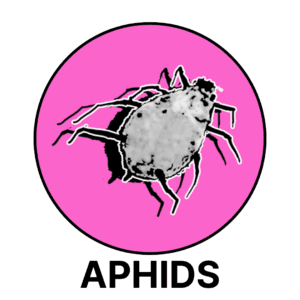Aphids are a common garden pest, but can be found on houseplants. There are many species that differ in color and appearance.

ABOUT APHIDS
There are more than 4,000 species of aphids! Some common ones you may see are the Oleander Aphid, Wooly Aphid, Green Peach Aphid, Melon Aphid and Black Bean Aphid.
Though they differ in appearance, each species is capable of destroying an otherwise healthy plant. Aphids feed on sap produced by the plant. After tapping into this sugary food supply a substance called “honey dew” may be noticed on the affected plant as a shiny, sometimes sticky residue.
Aphids reproduce quickly and efficiently—the female aphid does not need a male to fertilize her eggs
Complicating some treatments, especially outdoors, are certain species of ants known to guard and care for aphids, specifically so they can harvest the honeydew that the aphids produce. They will protect them from the weather, move them around to various locations on the plant, and attack any predators that threaten the aphids.

APHID DAMAGE
You will likely see aphids on the plant either before or when you first notice damage on the leaf. Damage can present as leaf curling, leaf discoloration/yellowing, and overall plant decline.
APHID TREATMENT
Endearingly called the Aphid Lion because of how effective of an aphid predator it is, Lacewing Larvae are going to be your best predator option. Even if you initially see the aphid population disappear completely after one release, it is recommended to continue to apply lacewing larvae every two weeks for at least three treatments, as aphids are very effective at reproducing and can rebound quickly.
If your plants are outside and you’re having trouble getting rid of aphids, you can also add in the predatory wasp – aphidius colemani. However these cannot be used alone and must be used in combination with lacewing larvae to get rid of active aphid issues.
If you find that there are ants that are complicating your beneficial treatment, you can add in the Nematodes Sc to help take down the ant population.





